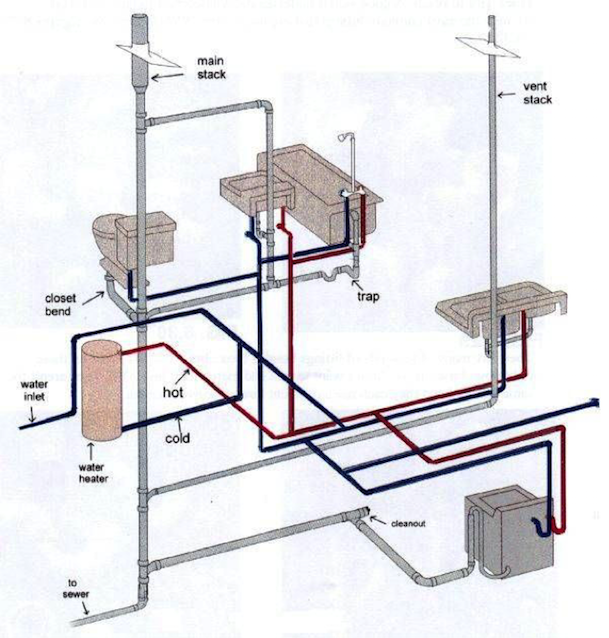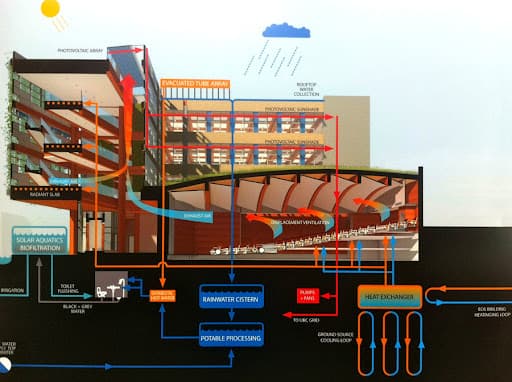An Overview to Your Home's Plumbing System Anatomy
An Overview to Your Home's Plumbing System Anatomy
Blog Article
Just how do you actually feel in regards to The Inner Workings of Your Home's Plumbing?

Understanding how your home's pipes system works is essential for every single house owner. From delivering tidy water for drinking, cooking, and bathing to safely eliminating wastewater, a properly maintained pipes system is vital for your family members's health and convenience. In this thorough overview, we'll discover the elaborate network that composes your home's plumbing and deal pointers on upkeep, upgrades, and taking care of typical problems.
Intro
Your home's pipes system is greater than simply a network of pipes; it's a complex system that ensures you have access to tidy water and effective wastewater removal. Understanding its parts and how they collaborate can help you prevent costly fixings and guarantee whatever runs smoothly.
Fundamental Components of a Pipes System
Pipelines and Tubing
At the heart of your pipes system are the pipes and tubing that bring water throughout your home. These can be made from different products such as copper, PVC, or PEX, each with its benefits in terms of durability and cost-effectiveness.
Fixtures: Sinks, Toilets, Showers, etc.
Fixtures like sinks, bathrooms, showers, and tubs are where water is used in your home. Recognizing exactly how these fixtures connect to the pipes system assists in identifying issues and preparing upgrades.
Shutoffs and Shut-off Factors
Shutoffs manage the flow of water in your pipes system. Shut-off shutoffs are vital during emergencies or when you need to make repairs, enabling you to separate parts of the system without disrupting water circulation to the entire house.
Supply Of Water System
Main Water Line
The main water line attaches your home to the metropolitan supply of water or a private well. It's where water enters your home and is dispersed to different fixtures.
Water Meter and Stress Regulatory Authority
The water meter procedures your water usage, while a pressure regulatory authority makes certain that water moves at a safe pressure throughout your home's plumbing system, preventing damages to pipelines and components.
Cold Water vs. Warm water Lines
Recognizing the difference between cold water lines, which provide water straight from the major, and warm water lines, which lug warmed water from the hot water heater, assists in repairing and preparing for upgrades.
Water drainage System
Drain Pipes Piping and Traps
Drain pipelines lug wastewater far from sinks, showers, and bathrooms to the drain or sewage-disposal tank. Traps prevent sewer gases from entering your home and additionally catch particles that might trigger clogs.
Ventilation Pipes
Air flow pipes permit air into the drainage system, protecting against suction that can slow down drain and create traps to vacant. Proper ventilation is essential for preserving the stability of your pipes system.
Significance of Correct Drain
Ensuring correct drain stops backups and water damages. On a regular basis cleansing drains and maintaining catches can avoid pricey repair services and extend the life of your pipes system.
Water Heating System
Sorts Of Hot Water Heater
Water heaters can be tankless or typical tank-style. Tankless heating units warmth water as needed, while storage tanks save warmed water for instant usage.
How Water Heaters Link to the Plumbing System
Comprehending just how water heaters link to both the cold water supply and warm water distribution lines aids in diagnosing issues like not enough hot water or leakages.
Maintenance Tips for Water Heaters
Frequently purging your hot water heater to remove debris, examining the temperature setups, and inspecting for leaks can expand its lifespan and improve energy effectiveness.
Usual Plumbing Concerns
Leaks and Their Reasons
Leaks can happen as a result of aging pipes, loosened installations, or high water pressure. Attending to leakages promptly avoids water damages and mold and mildew growth.
Clogs and Obstructions
Obstructions in drains pipes and toilets are typically triggered by purging non-flushable things or a build-up of grease and hair. Making use of drain screens and being mindful of what decreases your drains pipes can protect against blockages.
Indicators of Pipes Issues to Look For
Low tide stress, slow drains, foul odors, or unusually high water expenses are indications of potential plumbing problems that should be addressed promptly.
Pipes Upkeep Tips
Routine Evaluations and Checks
Set up yearly pipes evaluations to capture concerns early. Try to find indications of leaks, corrosion, or mineral build-up in taps and showerheads.
Do It Yourself Maintenance Tasks
Simple tasks like cleaning tap aerators, looking for bathroom leaks using color tablet computers, or protecting exposed pipelines in cool environments can avoid significant plumbing concerns.
When to Call an Expert Plumbing Technician
Know when a plumbing problem calls for professional experience. Attempting complicated fixings without appropriate expertise can lead to more damages and higher repair service expenses.
Updating Your Pipes System
Factors for Updating
Upgrading to water-efficient fixtures or replacing old pipelines can improve water top quality, decrease water bills, and boost the value of your home.
Modern Pipes Technologies and Their Benefits
Explore modern technologies like wise leak detectors, water-saving bathrooms, and energy-efficient water heaters that can conserve cash and decrease environmental impact.
Price Considerations and ROI
Compute the upfront expenses versus long-term financial savings when considering pipes upgrades. Many upgrades pay for themselves via decreased utility costs and fewer repair work.
Ecological Effect and Conservation
Water-Saving Components and Home Appliances
Installing low-flow taps, showerheads, and bathrooms can considerably minimize water usage without giving up efficiency.
Tips for Reducing Water Use
Easy habits like repairing leakages quickly, taking much shorter showers, and running full loads of washing and dishes can preserve water and lower your energy bills.
Eco-Friendly Pipes Options
Think about lasting plumbing products like bamboo for flooring, which is durable and environmentally friendly, or recycled glass for kitchen counters.
Emergency situation Readiness
Actions to Take Throughout a Pipes Emergency situation
Know where your shut-off shutoffs lie and just how to turn off the water system in case of a ruptured pipe or major leakage.
Relevance of Having Emergency Contacts Helpful
Keep get in touch with details for regional plumbing professionals or emergency services easily offered for fast response during a plumbing crisis.
DIY Emergency Situation Fixes (When Relevant).
Temporary fixes like utilizing air duct tape to patch a leaking pipeline or positioning a pail under a dripping faucet can reduce damage up until a specialist plumbing professional arrives.
Conclusion.
Understanding the composition of your home's plumbing system equips you to preserve it efficiently, saving time and money on fixings. By following regular maintenance routines and staying informed about modern plumbing technologies, you can ensure your plumbing system operates efficiently for years to come.
HOW YOUR PLUMBING SYSTEM WORKS
Which Pipes Do What?
Blue lines = fresh water supply entering the building
Red lines = hot water supply entering the building
Grey lines = pipes carrying waste away from the building and venting pipes carrying gases away from the building (through the roof)
YOUR MAIN PLUMBING SYSTEMS
There are two main plumbing systems that support your home s basic plumbing needs one that brings clean water into your home, and one that sends dirty water away from your home. Connected to the toilet, bath, shower, and other faucets in your home, these two systems keep your water flowing in the right directions.
ACCESSING FRESH WATER
Fresh and clean water is brought into your home through the main water supply line . Filtered through one pipe, this water is pressured to flow into the various fixtures in your home at any given time.
This water can be sourced from a well located on your property, a pond or river (mostly cottages), or, as in most cases, from the city s municipal water treatment centre. However, it is important to note that water that is untreated, such as the water siphoned from ponds or rivers, may not be safe to drink. Personal water supplies always need to be treated for hardness and contaminants before consumed.
MUNICIPAL WATER SUPPLIES
Improve taste and odour
Remove sediment
Eliminate hardness
Reduce chlorine
COLD WATER SUPPLY VS. HOT WATER SUPPLY
Cold water flows into your home or building through the service line, which then distributes hot or cold water to your fixtures. This line is most commonly run through a central column that runs floor to floor. Hot water runs in short and straight pipes as the longer the pipeline, the more heat that will be lost in the transfer. Having shorter pipes also allows residents to access hot water more quickly.
WASTE WATER SYSTEM
Your wastewater system is divided into two parts pipes that send wastewater away from your home and venting pipes that send sewer gas away from your home. Sewage water travels through pipes that flush the water and waste towards local sewers that are operated and managed by your city or town. Most sewer systems rely on gravity to move the wastewater to where it needs to go.
The further away from your toilet or sink, the larger wastewater pipes become. This allows for waste to be disposed of from various parts of your home or business at once without pipe blockages. The angle and flow of these pipes are also essential for keeping your waste pipes clear of build up.
https://harrisplumbing.ca/how-your-home-plumbing-system-works/

HOW YOUR PLUMBING SYSTEM WORKS
Which Pipes Do What?
YOUR MAIN PLUMBING SYSTEMS
There are two main plumbing systems that support your home s basic plumbing needs one that brings clean water into your home, and one that sends dirty water away from your home. Connected to the toilet, bath, shower, and other faucets in your home, these two systems keep your water flowing in the right directions.
ACCESSING FRESH WATER
Fresh and clean water is brought into your home through the main water supply line . Filtered through one pipe, this water is pressured to flow into the various fixtures in your home at any given time.
This water can be sourced from a well located on your property, a pond or river (mostly cottages), or, as in most cases, from the city s municipal water treatment centre. However, it is important to note that water that is untreated, such as the water siphoned from ponds or rivers, may not be safe to drink. Personal water supplies always need to be treated for hardness and contaminants before consumed.
MUNICIPAL WATER SUPPLIES
COLD WATER SUPPLY VS. HOT WATER SUPPLY
Cold water flows into your home or building through the service line, which then distributes hot or cold water to your fixtures. This line is most commonly run through a central column that runs floor to floor. Hot water runs in short and straight pipes as the longer the pipeline, the more heat that will be lost in the transfer. Having shorter pipes also allows residents to access hot water more quickly.
WASTE WATER SYSTEM
Your wastewater system is divided into two parts pipes that send wastewater away from your home and venting pipes that send sewer gas away from your home. Sewage water travels through pipes that flush the water and waste towards local sewers that are operated and managed by your city or town. Most sewer systems rely on gravity to move the wastewater to where it needs to go.
The further away from your toilet or sink, the larger wastewater pipes become. This allows for waste to be disposed of from various parts of your home or business at once without pipe blockages. The angle and flow of these pipes are also essential for keeping your waste pipes clear of build up.
https://harrisplumbing.ca/how-your-home-plumbing-system-works/
As a person who reads about Exploring Your Homes Plumbing Anatomy, I think sharing that excerpt was a great idea. Enjoyed our post? Please quickly share it. Let other people discover it. Thank you so much for your time invested reading it.
Click Here Report this page